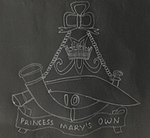10th Princess Mary's Own Gurkha Rifles
| 10th Princess Mary's Own Gurkha Rifles | |
|---|---|

Cap badge of the 10 Gurkha Rifles
|
|
| Active | 1890–1994 |
| Country |
|
| Branch | British Army |
| Type | Rifles |
| Role | Light Infantry |
| Size | First battalion (Second: 1903–68, Third: 1940–47, Fourth: 1941–46) |
| Garrison/HQ |
Quetta Alhilal Taiping Seremban British Hong Kong |
| Colors | Rifle Green Facings, Black Piping, Black Lanyard |
| March | Quick: Hundred Pipers |
| Engagements | Burma 1885–87; (The Great War): Helles, Krithia, Suvla, Sari Bair, Gallipoli 1915, Suez Canal, Egypt 1915, Sharqat, Mesopotamia 1916–18, Afghanistan 1919 (Second World War): Iraq 1941, Syria 1941, Bologna, Italy 1944–45, Monywa 1942, Tamu Road, Mandalay, Kyaukse 1945, Burma 1942–45 |
| Commanders | |
| Notable commanders |
Brigadier Godfrey Bartlett Proctor |
| Insignia | |
| Shoulder Flash | |
| Abbreviation | 10 GR |
The 10th Princess Mary's Own Gurkha Rifles, (abbreviated to 10 GR), was originally a rifle regiment of the British Indian Army comprising Gurkha soldiers of Nepalese origin. The regiment was first formed in 1890, taking its lineage from a police unit and over the course of its existence it had a number of changes in designation and composition. It took part in a number of campaigns on the Indian frontiers during the 19th and early 20th centuries, before fighting in the First World War, the Third Anglo-Afghan War and the Second World War. Following India's independence in 1947, the regiment was one of four Gurkha regiments to be transferred to the British Army. In the 1960s it was active in the Malayan Emergency and Indonesian Confrontation. It was amalgamated with the other three British Gurkha regiments to form the Royal Gurkha Rifles in 1994.
At the end of the Third Burmese War in 1887, it was decided to withdraw the regular army battalions and replace them with a freshly recruited military police force. Recruited in India, it was intended that the military police would be a temporary force which would establish order in districts of upper Burma and then hand over those districts to the civil police. The military police would then be used to form additional regular battalions of the Indian Army. The Kubo (Kabaw) Valley Military Police were raised on 9 April 1887 by Sir F.B. Norman (OC Eastern Frontier Brigade) at Manipur in India and was composed in equal numbers of Gurkha recruits and Assam hillmen. The first commander was Lieutenant C.W. Harris. The battalion moved to Burma and was initially stationed at Tamu.
In 1890, it was decided to convert the Kubo Valley Military Police Battalion in Burma into a new battalion with the title of 10th Madras Infantry. The 10th Madras Infantry, one of the oldest battalions in the Indian Army, had recently been disbanded. The new battalion had no association with the old except for the name. The relics of the battalion were eventually taken back to India.
...
Wikipedia
